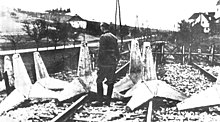7th Army (Yugoslavia)
| 7th Army | |
|---|---|

Yugoslav obstacles placed across railway tracks near Spielfeld on the Yugoslav–Reich border
|
|
| Active | 1941 |
| Country |
|
| Branch | Royal Yugoslav Army |
| Type | Infantry |
| Size | 20,000 - 30,000 soldiers |
| Part of | 1st Army Group |
| Engagements | Invasion of Yugoslavia |
| Disbanded | 1941 |
| Commanders | |
| Notable commanders |
Dušan Trifunović |
The 7th Army was a Royal Yugoslav Army formation raised prior to the German-led Axis invasion of Yugoslavia in April 1941, during World War II. It consisted of two divisions, two brigade-strength mountain detachments, and a brigade-strength infantry detachment. It formed part of the 1st Army Group, and was responsible for the defence of Yugoslavia's north-western frontier with Italy and Nazi Germany.
Despite concerns over a possible Axis invasion, orders for the general mobilisation of the Royal Yugoslav Army were not issued by the government until 3 April 1941, out of fear this would offend Adolf Hitler and precipitate war. When the invasion commenced on 6 April, the 7th Army was only partially mobilised, and on the first day the Germans seized several mountain passes and bridges over the Drava river. Slovene politicians formed a National Council of Slovenia with the intent of separating from Yugoslavia, and on the right flank of the 7th Army, the 4th Army was seriously weakened by Croat fifth column activities within its major units and higher headquarters from the outset. This alarmed the 7th Army commander, Divizijski đeneralDušan Trifunović, but he was not permitted to withdraw from the border areas until the night of 7/8 April, and this was followed by the German capture of Maribor on 8 April as they continued to expand their bridgeheads, supported by the Luftwaffe.
...
Wikipedia
